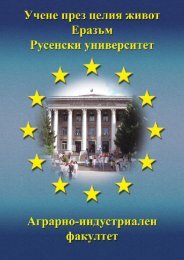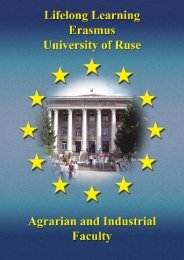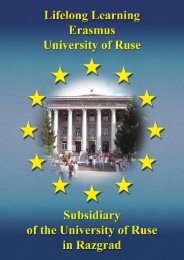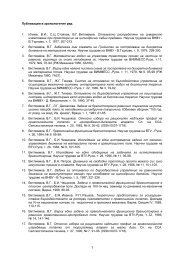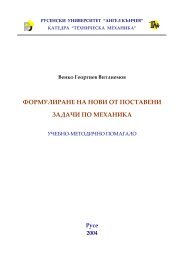Erasmus ECTS Information Package
Erasmus ECTS Information Package
Erasmus ECTS Information Package
Create successful ePaper yourself
Turn your PDF publications into a flip-book with our unique Google optimized e-Paper software.
<strong>Erasmus</strong> <strong>ECTS</strong> <strong>Information</strong> <strong>Package</strong><br />
Faculty of EEEA<br />
3210 Automation of Design in Electronics<br />
<strong>ECTS</strong> credits: 6<br />
Workload per week: 3lec+0sem+0labs+2ps+cw<br />
Assessment: exam<br />
Type of exam: written and oral<br />
Departments involved:<br />
Department of Electronics<br />
Faculty of Electrical Engineering, Electronics and Automation<br />
Lecturers:<br />
Assoc. Prof. Ivan Borisov Evstatiev, MEng, PhD, Dept. of Electronics,<br />
tel.: 888 772, Е-mail: ievstatiev@ecs.uni-ruse.bg<br />
Abstract:<br />
The subject Automation of Design in Electronics has been included as a compulsory one in the syllabus of fourth<br />
year students of Electronics. It acquaints the students with the theoretical grounding, the structure of the<br />
programmes and their application for the automation of the design of electronic apparatuses with the help of<br />
electronic - computing devices. Course prerequisites include the knowledge of Mathematics, Analog devices and<br />
Theory of electronic devices.<br />
Course content:<br />
General characteristics of the automation of the design. Methods for machine analysis. Numerical methods for<br />
solving the equations of linear circuits and devices. Frequency analysis of electronic circuits. Stability of the<br />
electronic circuits. Non-linear direct current analysis of electronic circuits. Analysis of transition processes in<br />
electronic circuits. Tolerance analysis of electronic circuits and devices. Optimisation of electronic circuits and<br />
devices. Automatization of the design of constructive documentation. Automatization of the design of bare printed<br />
plates.<br />
Teaching and assessment:<br />
Lectures last 2 hours (the first week 2x2 hours, the next week 1x2 hours), an average of 3 hours per week. The<br />
exercises are of a duration of 4 hours and are conducted every other week. After each laboratory exercise the<br />
students prepare and present reports which are signed by the lecturer. The reports are used by the students<br />
during the exam. The continuous assessment is done during the exercises and includes pre-lab testing, giving<br />
assignments and checking their completion.<br />
3216 Electronic Regulators<br />
<strong>ECTS</strong> credits: 3<br />
Weekly classes: 2lec+0sem+0labs+1ps+p<br />
Assessment: continuous assessment<br />
Type of exam: written<br />
Departments involved:<br />
Department of Automatics and Mechatronics<br />
Faculty of Electrical Engineering and Automation<br />
Lecturers:<br />
Assoc. Prof. Venelin Iliev Yakov, MEng, PhD, Dept of Automatics and Mechatronics,<br />
tel.: 888 269.<br />
Abstract:<br />
The Electronic regulators course aims to acquaint the students of Electronics with the principles and practical<br />
implementation of electronic regulators for operating of technological processes and objects. Apparatus devices<br />
and the algorithms for their functioning are discussed. Special attention is paid to the linear digital and the<br />
specialized local devices, and to the multichannel regulating devices, as well.<br />
Course content:<br />
Regulating devices – types. Main characteristics. Position regulators. Element knots and basic structure schemes<br />
of linear electronic regulators. Transitive processes, functional dependencies and back connections in the<br />
industrial regulators. Principle schemes of industrial regulators. Digital regulators. Formation of operational<br />
algorithms. Exthermal regulators. Main types. Regulators with alternating structure.<br />
Teaching and assessment:<br />
During the lectures the main topics of the study material are discussed.<br />
Seminars are conducted in cycles and the students are divided into subgroups.<br />
The students’ preparation is checked at the beginning of each practice session. The students prepare an individual<br />
report after a given model for each of the practice sessions.<br />
Method of assessment: continuous assessment based on two tests.<br />
103



